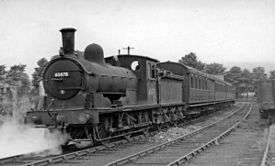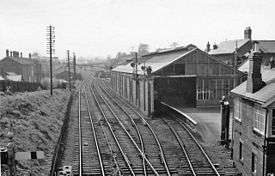Bishop Auckland railway station
| Bishop Auckland | |
|---|---|
 | |
| Location | |
| Place | Bishop Auckland |
| Local authority | County Durham |
| Coordinates | 54°39′26″N 1°40′40″W / 54.6573°N 1.6778°WCoordinates: 54°39′26″N 1°40′40″W / 54.6573°N 1.6778°W |
| Grid reference | NZ208291 |
| Operations | |
| Station code | BIA |
| Managed by | Northern Rail |
| Number of platforms | 1 |
| DfT category | F1 |
|
Live arrivals/departures, station information and onward connections from National Rail Enquiries | |
| Annual rail passenger usage* | |
| 2004/05 | 66,681 |
| 2005/06 |
|
| 2006/07 |
|
| 2007/08 |
|
| 2008/09 |
|
| 2009/10 |
|
| 2010/11 |
|
| 2011/12 |
|
| 2012/13 |
|
| 2013/14 |
|
| History | |
| Original company | Bishop Auckland and Weardale Railway |
| Pre-grouping | North Eastern Railway |
| Post-grouping | London and North Eastern Railway |
| 8 November 1843 | Station opened |
| National Rail – UK railway stations | |
| * Annual estimated passenger usage based on sales of tickets in stated financial year(s) which end or originate at Bishop Auckland from Office of Rail and Road statistics. Methodology may vary year on year. | |
| UK Railways portal | |


Bishop Auckland railway station serves the town of Bishop Auckland in County Durham, England. The station is the terminus of the Tees Valley Line 12 miles (19 km) north of Darlington. The station is on the Bishop Line.
Current
The station is operated by Northern Rail, which provides Network Rail passenger services. In 2012, Bishop Trains adopted the station from Northern Rail, providing a National Rail Ticket Office and staff for the station. Bishop Trains have further developed the Ticket Office and now provide International rail ticket sales, coach trips and holidays, and more recently, rail charters.
In 2014, the station was revamped. In the former toilet block, a glass front waiting room was constructed, alongside a new toilet and office.
Services
Trains depart southbound to Darlington, Middlesbrough and Saltburn roughly once every two hours, increasing to hourly at peak times (10 each way in total). The Sunday service is also two-hourly and, during the summer, includes a through train to Whitby via the Esk Valley Line.[1] The new Northern franchise operator Arriva Rail North plans to improve the base frequency to hourly (including Sundays) in the future, once the new franchise agreement comes into force in April 2016.[2]
Bishop Auckland West
Weardale Railway built a separate platform, called Bishop Auckland West, about 110 yards (100 m) west of the Northern Rail station, from which regular passenger services to Stanhope operated from May 2010 until the end of 2012.[3] No regular timetabled services have served Bishop Auckland West since then.[4]
History
Bishop Auckland gained its first rail link in 1842,[5] when the Stockton and Darlington Railway (S&DR) backed Bishop Auckland and Weardale Railway (BA&WR) gained the powers via an Act of Parliament to build a railway line from the S&DR's station at Shildon via Bishop Auckland and Witton-le-Wear into Crook, County Durham.[6]
The company initially built a temporary terminus at South Church, which opened on 19 April 1842. A road coach service then extended the service into Bishop Auckland, and a secondary road coach service also ran to Rainton Meadows. After completion of the Shildon tunnel, the BA&WR erected a permanent station on the current site, which opened to freight on 8 November 1843, and passengers on 30 January 1843.[6] All operations were sub-leased as agreed to the S&DR.[6]
In 1844, after the West Durham Railway extended from a junction with the Clarence Railway at Byers Green to Crook, the S&DR extended the BA&WR from Bishop Auckland along the river valley to Witton-le-Wear, and then into Crook. In 1845, the S&DR came to an agreement with the Derwent Iron Company to sub-lease the southern section of the former Stanhope and Tyne Railway. It extended the line from Crook to Waskerley and then to Blackhill, and it was opened as the Weardale Extension Railway (WXR).[6][7]
In July 1845 Parliament passed the Wear Valley Act, which allowed the extension of the BA&WR from a junction at Witton-le-Wear to Frosterley, and a small branch line across the river to Bishopley. With all works again undertaken by the S&DR, this line opened on 3 August 1847. After these works had been completed, the BA&WR amalgamated with the WXR. All service were operated by the S&DR, which officially took over the new company in January 1857.[6][7]
On 1 April 1857, the North Eastern Railway (NER) started a service from Durham to Bishop Auckland at a new terminus in Tenter Street. However, the S&DR and NER quickly came to the agreement of development of a joint station in the town, and so rebuilt the existing former BA&WR station, with NER trains using it from December 1857.[6][7]
In 1862, an Act of Parliament was passed allowing the S&DR backed Frosterley & Stanhope Railway to extend the line to Stanhope, thus allowing trains to transport limestone from the Newlandside Estate on the south side of the town. This brought about the extension of the South Durham and Lancashire Union Railway from Barnard Castle into Bishop Auckland in 1862, and with the final addition of traffic from an extension of the Clarence Railway at Byers Green, eventually resulted in the NER rebuilding the station again in December 1867.[6][7]
The final extension of the Weardale Railway to Wearhead opened on 21 October 1895, with the NER having resited the station at Stanhope to provide a more suitable gradient for the heavy limestone trains. Between Eastgate and Westgate at Cambo Keels, sidings were established to serve the Weardale Iron Company's Heights limestone quarry, which is still in operation today. This final extension of the Weardale Railway bought about the final and largest layout of Bishop Auckland railway station, which was now rebuilt in triangular form with four platforms in 1905.[6][7] Only three of these were normally used for passenger trains, with platform 1 handing trains towards Crook & Wearhead and platforms 2 & 3 dealing with services on the Barnard Castle, Ferryhill & Durham lines. Platform 4 (on the chord linking the Durham & Crook lines) was mostly used for parcels & newspaper traffic and for racing pigeon specials.
As elsewhere the UK, rail traffic in the area declined after World War II, with the Wearhead branch the first to lose its passenger trains in 1953. The principal closures came in the 1960s mainly as a result of the Beeching Axe, with services to: Barnard Castle via West Auckland ending in June 1962; Durham in May 1964;[8] and Crook in March 1965. This left only the former original S&DR line to Darlington line in operation, along with the freight-only branch traffic to Eastgate.[6][7]
The station remained more or less intact (although increasingly forlorn and run-down) for more than 20 years thereafter, though by the early 1980s only the former platform 3 was in use[7] (along with the former Bishop Auckland East signal box). It was eventually replaced by the current structure on 6 June 1986. This stands on the site of the former Crook branch platform, on a siding off the now single 'main' line which continues on towards Stanhope & Eastgate. The signal box was abolished at the same time, with neighbouring Shildon box assuming control of the much-simplified layout.
The remaining station buildings were then demolished and the site sold off for retail redevelopment. The former goods yard is now a supermarket with carpark, and the Durham platform is now the site of a cycling and motoring store and a bank.[7]
References
- Body, G. (1988). PSL Field Guides - Railways of the Eastern Region Volume 2. Wellingborough: Patrick Stephens Ltd. ISBN 1-85260-072-1.
- Butt, R.V.J. (1995). The Directory of Railway Stations. Yeovil: Patrick Stephens Ltd. ISBN 1-85260-508-1. R508.
Notes
- ↑ Northern Rail Timetable 3 - Bishop Auckland and Darlington to Middlesbrough and Saltburn, 19 May - 7 December 2013. Retrieved 8 August 2013.
- ↑ Northern Franchise Improvements - DfT
- ↑ Weardale Railway News 2010
- ↑ Weardale Railway website timetables tab. Retrieved 9 June 2013.
- ↑ Body 1988, p. 43
- 1 2 3 4 5 6 7 8 9 Butt 1995, p. 35
- 1 2 3 4 5 6 7 8 "Bishop Auckland". Disused Stations. 2 March 2012.
- ↑ Subterranea Britannica - Bishop Auckland
External links
- Buses from the station
- Buses to the station
- Bishop Line
- Bishop Auckland Railway Station
- Bishop Trains
- Railscot - Bishop Auckland
| Preceding station | Following station | |||
|---|---|---|---|---|
| Northern Rail | Terminus | |||
| Historical railways | ||||
| South Church Line open, station closed |
Stockton and Darlington Railway Bishop Auckland & Weardale Railway |
Etherley & Witton Park Line and station closed | ||
| Disused railways | ||||
| West Auckland Line and station closed |
North Eastern Railway Stockton and Darlington Railway |
Terminus | ||
| |
||||
| Wolsingham | Weardale Railway | Terminus | ||
| ||||||||||||||||||||||||||||||
